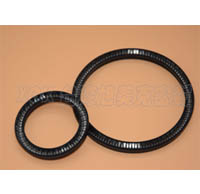AEM
1、physical and chemical properties
The polyethylene / acrylate rubber is a copolymer of ethylene and methacrylate, such as a small amount of a carboxylic acid group-containing sulfide monomer. Ethylene / Acrylic Rubber is a durable, low permanent compression strain rate of rubber, with excellent high temperature, heat resistant mineral oil, hydraulic oil and weather resistance. AEM low temperature elasticity and mechanical properties than ACM, but it is not resistant to low aniline oil (such as ASTM grade 3) and polar solvents.
PS:
ACM acrylic rubber positioning is cost-effective, hot oil environment and the effect of almost fluorine rubber. In the case of nitrile rubber can not meet the requirements, while not willing to use expensive fluorine rubber in the case of use. But its processing performance is poor. ACM there are difficulties in processing: stick stick, stick mold, pollution mold, and low temperature is not OK, the pressure is not good and other defects, so the development of an improved version of acrylic rubber: AEM rubber, make up for these defects. AEM's processing performance and high and low temperature performance than ACM to improve, while prices also increased. Polyacrylate rubber (ACM) and ethylene - acrylate rubber (AEM) difference is: AEM good performance in all aspects, but the price is expensive AEM, and almost the same fluorine rubber.
2、 the temperature range
-30 ℃ -180 ℃, 180 ℃ for a short time
3、 hardness range
Shore A40 degrees to 85 degrees
4、 color
Black, white, orange, can also be specified by the customer color
5、 application
AEM is usually used in those than nitrile rubber, neoprene performance requirements of high occasions, or need to reduce the high-end rubber (such as fluorine rubber) the use of the cost of the occasion. Mainly used in the manufacture of automotive engine oil and transmission oil seals.






